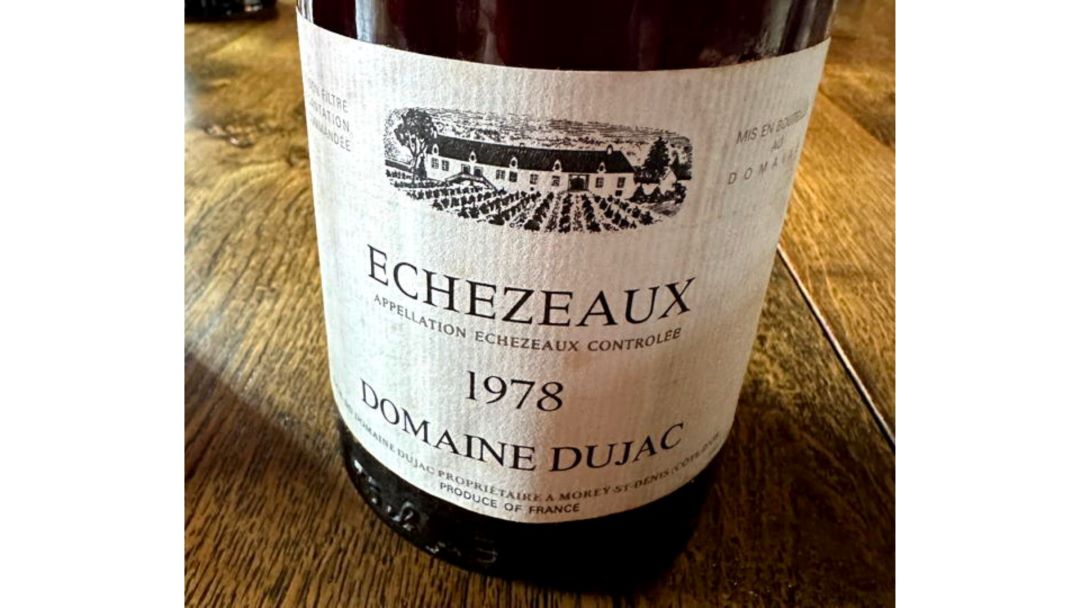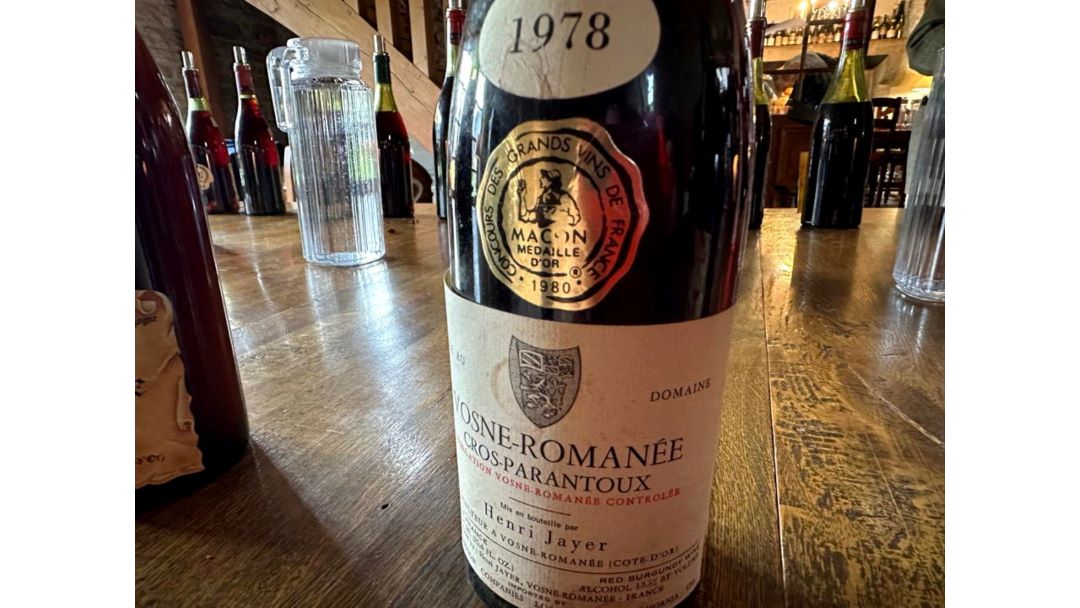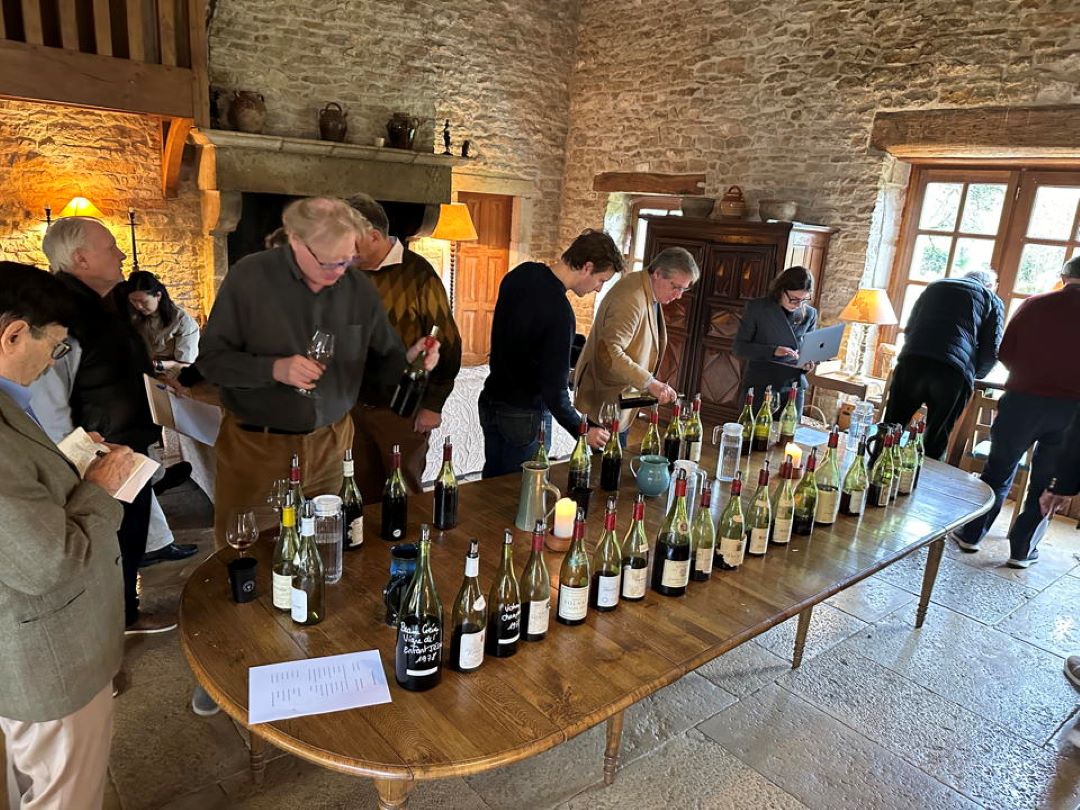Browse using the new Vinous website now. Launch →
Printed by, and for the sole use of . All rights reserved © 2015 Vinous Media
Grape Expectations: Burgundy 1978 Retrospective
BY NEAL MARTIN | APRIL 23, 2025
I love the smell of ‘78 Burgundy in the morning. Actually, morning, noon or night. Any time is good for me.
I take a deep breath. Fill my lungs. Someone hands me a crib sheet, and I examine this morning’s order of play and…Jesus, Mary and Joseph…
“Have you seen this list of fermented grape juice?” I quietly ask a fellow attendee. Is someone playing a joke? My eyes bulge like a cartoon character as I look down the veritable who’s who of the Côte d’Or and then at the long table where those same wines are lined up in two parallel rows.
Rousseau
Chambertin…check.
DRC…check. Twice.
Clos des Ducs, de Vogüé Musigny, Roumier Bonnes-Mares, La Romanée, the Ruchottes from Mugneret-Gibourg, Dujac and…OMG…is that real? Cros-Parantoux from Henri Jayer. That’s a holy grail. Thinking about it, it’s probably more expensive than the actual Holy Grail. Bottles sell for north of £20,000 these days. On the other hand, drinking Jayer does not guarantee eternal youth, just eternal bragging rights.
This informal and friendly tasting took place at the late Becky Wasserman's home in Bouillard, France.
Merchants lauded the 1978s upon release, perhaps sprinkling on an extra teaspoon of hyperbole since they had endured a disappointing decade. The 1978 growing season was salvaged by warm, dry weather from August through to harvest, which did not commence until October 6 in the Côte de Beaune and three days later in the Côte de Nuits. It was a small crop due to uneven flowering that dragged on for over a fortnight. Consequently, many domaines’ yields were between 25 and 30 hectoliters per hectare, predicating a fleet of ripe, tannic, robust reds built for long-term aging. The 1978 reds shaded the whites, which were marked by underripe flavours.
Much of
this treasure trove had been donated by a renowned collector/oenophile whose
altruism knows no bounds. The venue is in picturesque Bouilland, France, in the
home of the late Becky Wasserman and her husband, Russell Hone, who holds court
in the adjacent kitchen. (It is the same room where Jay McInerney conducted his
Mugnier
vertical around the same time.) This is a casual tasting with no
formalities, no set kick-off time. Some people mill around chatting to old
friends. There is no predesignated order to taste. Everyone knows everyone, as is
often the case in Burgundy. I set up my iPad on a spare sideboard, take a glass
and commence the tasting of a lifetime.
Except, it isn’t.
This is one of those occasions when Lady Luck has buggered off, a tasting undermined by the banal fact that 1978 was almost half a century ago. Factor in that viticultural practices at the time could be less fastidious than desirable, and the mantra for many was quantity over quality (I was intrigued to read in fellow attendees Allen Meadows’ and Doug Barzelay’s indispensable “Burgundy Vintages” tome that Charles Rousseau admitted his ‘78s fell short of their potential). Blend in terrible luck with corked bottles, such as the Roumier’s Bonnes-Mares (ouch) and Engel’s Clos-Vougoet (double ouch), plus three or four that were just out of condition, and all this conspired to capsize this once-in-a-lifetime horizontal to the point where halfway through, I found myself desperately seeking positives. It’s just one of those things. My job is to convey reality, not what I would have wished to write, hence the lowly scores for bottles where you might anticipate greatness.

Fortunately, scattered among the disappointments is a clutch of bottles that sparkle like rubies in the sand, none more so than a stunning 1978 Echézeaux from Domaine Dujac. Jacques Seysses produced some heavenly wines in that decade. Nothing else here matches its vivacity, intensity and complexity. Tensile and poised, the 1978 Volnay Clos de la Bousse d'Or from Domaine Pousse d’Or is a testament to the late great winemaker Gérard Potel. Both Musignys from Domaine Drouhin and Domaine Georges Comte de Vogüé put in solid performances, the latter perhaps the last great vintage before the domaine went off the boil through the eighties. The tasting serves as a pertinent reminder that established names could produce the goods, with both the 1978 Chambertin Clos-de-Bèze from Faiveley and a magnum of 1978 Corton-Grancey from Louis Latour passing muster. The two 1978s from Domaine de la Romanée-Conti show very well, not least the sublime 1978 La Tâche, clearly more complex than the Romanée-Saint-Vivant.
The three whites show well. You would expect that from Bonneau du Martray’s Corton-Charlemagne and Domaine des Comtes Lafon’s Meursault Les Perrières (made by René Lafon, his son Dominique having just enrolled at the Lycée Viticole). But kudos also to the Meursault Perrières from Robert Ampeau, which is definitely not embarrassed in this lineup.

What about the fabled 1978 Vosne-Romanée Cros-Parantoux, the maiden vintage? Henri Jayer had hitherto blended fruit from the vineyard into his Vosne-Romanée Village. The 1.01-hectare vineyard was purportedly once the site of a quarry and brushland during the thirties, apart from one enterprising factotum at Camuzet who planted it with artichokes. Jayer, working as a métayeur for Domaine Camuzet, acquired his first plot in Cros Parantoux in 1951. He famously had to dynamite the largest immovable boulders. Jayer was plagued by obstinate artichoke roots, the vegetable presumably miffed at being usurped after the first vines were planted in 1953. Unusually, the INAO granted Premier Cru status almost immediately. Compare that with the aeons it has taken the likes of Marsannay and Pouilly-Fuissé to achieve the same. Jayer continued to expand his holdings in Cros Parantoux, the last acquisition in 1970, so that he amassed 0.715 hectares in total. Jayer’s tenets included low yields and maturation entirely in new oak barrels.
Sure, the 1978 Cros-Parantoux is a lovely mature Pinot Noir, perhaps a little more youthful than expected, certainly not disguising the imprimatur of the oak regime. However, I tell it how it is. There’s nothing faulty about the Jayer bottle, but it doesn’t exactly set off fireworks. I wager that it took a few years for the vineyard to achieve the greatness experienced first-hand in the late eighties/early nineties. In this tasting, the Echézeaux from Dujac is superior.
After the tasting, a quick bite to eat, a chat with Russell Hone, then a drive to Saint-Aubin to see Olivier Lamy. It was a privilege to attend this 1978 horizontal. It is a shame that a disproportionately large percentage of bottles did not show well on the day. There is always a risk when broaching old bottles, especially Pinot Noir from an era besmirched by swings in quality—from experience, more so than Bordeaux. Rerun exactly the same tasting and you could end up with different results. Perchance, a more positive conclusion.
Perhaps some of these 1978s should have been blended with water poured from the Holy Grail.
© 2025, Vinous. No portion of this article may be copied, shared or redistributed without prior consent from Vinous. Doing so is not only a violation of our copyright but also threatens the survival of independent wine criticism.
You Might Also Enjoy
The Lord Giveth…Burgundy 2023, Neal Martin, January 2025
Burgundy 2023: The State of Play, Neal Martin, January 2025
Future Memories: DRC 2022 In Bottle, Neal Martin, February 2025
2023 Burgundy Supplement, Antonio Galloni, February 2025
Domaine J-F Mugnier Musigny Retrospective: 1993-2016, Jay McInerney, February 2025
Archive Away: Mature Burgundies 1919-2019, Neal Martin, June 2024
A Century of...Fours, Neal Martin, June 2024
Show all the wines (sorted by score)
- Domaine Armand Rousseau
- Domaine Bonneau du Martray
- Domaine Bouchard Père & Fils
- Domaine Camus
- Domaine Cathiard-Molinier
- Domaine Charles Vienot
- Domaine Clair-Daü
- Domaine Clos du Tart
- Domaine Comte Georges de Vogüé
- Domaine de Courcel
- Domaine de la Pousse d'Or
- Domaine de la Romanée-Conti
- Domaine des Comtes-Lafon
- Domaine Drouhin-Laroze
- Domaine du Comte Liger-Belair (Bouchard Père et Fils)
- Domaine Dujac
- Domaine Faiveley
- Domaine Georges Roumier
- Domaine Gros Frère et Soeur
- Domaine Henri Jayer
- Domaine Henry Lamarche
- Domaine Jean Gros
- Domaine Joseph Drouhin
- Domaine Mugneret-Gibourg
- Domaine René Engel
- Domaine Robert Ampeau
- Les Héritiers de Mme. François de Montille
- Louis Latour
- Lupé-Cholet



